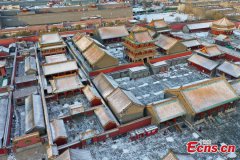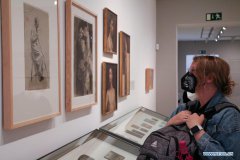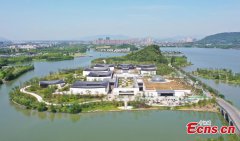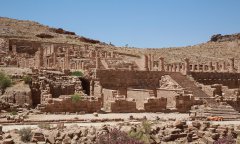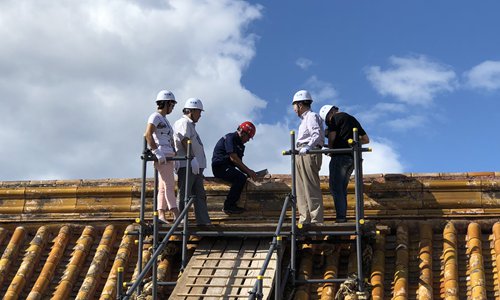
Workers remove a ceremonial box from the roof of The Hall of Mental Cultivation in the Palace Museum in Beijing on Monday. Photo:Luo Yunzhou/GT
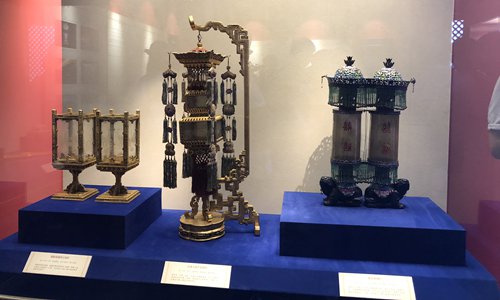
Items from The Hall of Mental Cultivation on display Photo:Luo Yunzhou/GT
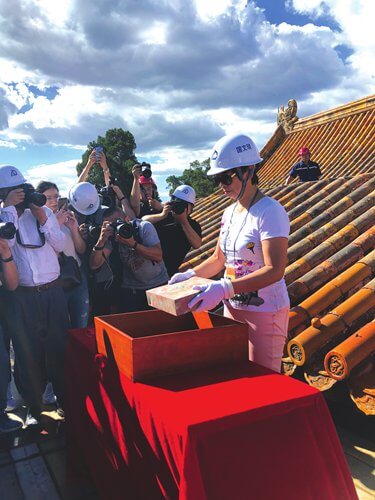
Xu Chaoying, an expert from the Palace Museum, places the ceremonial box into storage during a ceremony held at the Palace Museum on Monday. Photo:Luo Yunzhou/GT
With the rising popularity of Chinese historical dramas The Story of Yanxi Palace and Ruyi's Royal Love in the Palace, learning more about palace life in ancient China has become extremely trendy among young people in China.
"Look at the visitors outside 'The Hall of Mental Cultivation' exhibition, we have to stand in two rows to line up," netizen Lu Xi posted on Sina Weibo along with a picture of the long line of people waiting to see the Capital Museum's exhibition about the famous hall in the Forbidden City that once acted as a work and living space for numerous emperors.
The Capital Museum is not the only place to feature an exhibition about the hall, museums elsewhere in Beijing and other cities such as Nanjing and Hong Kong are also holding exhibitions introducing The Hall of Mental Cultivation, or Yangxin Dian in Chinese, which is currently undergoing renovation.
Restoration launch
After two years of preparation, renovation of The Hall of Mental Cultivation was officially kicked off with a ceremony held on Monday in the Palace Museum, which is housed within the Forbidden City.
"To satisfy visitors who want to learn more about The Hall of Mental Cultivation during the restoration period, a series of exhibitions are being held in several cities in China," Shan Jixiang, the director of the Palace Museum, explained at the media conference.
To ensure everything would go smoothly, the restoration team began documenting, labeling and analyzing every inch of the hall in December 2015.
The restoration project involves the hall itself and another 12 ancient buildings spread over 7,707 square meters of space within the museum.
"Our restoration standards require we stay as faithful as possible to the original appearance of the old buildings," Shan told the Global Times at the launch.
Another important part of the ceremony involved moving a decorative box located in the roof of the hall, known as a baoxia, to a storage room where it will be kept during the renovation. Baoxia are special boxes decorated with various auspicious symbols within which were placed various precious items. The boxes were placed in small compartments in the roofs of buildings throughout the Forbidden City to attract good fortune.
"The color painting on the box makes it stand out from others [found in the Forbidden City]," Xu Chaoying, an expert from the Palace Museum, told the Global Times.
"We haven't opened it yet, but the decorations are much more detailed than other boxes we have found in other halls," Xu said.
The baoxia will be placed back on the roof after the restoration is completed.
Political hub
In Chinese historical dramas, The Hall of Mental Cultivation is portrayed as a place where the emperor goes when he wants to rest and get away from the pressures of running the country. In reality, however, it was the main work space for a number of Qing Dynasty (1644-1911) emperors.
Built in 1537, during the reign of the Ming Dynasty (1368-1644) Jiajing Emperor, The Hall of Mental Cultivation has undergone many changes over the centuries.
Initially, it was used as a resting area by emperors, but after the Qing Dynasty Shunzhi Emperor passed away in the hall from smallpox, his son the Kangxi Emperor began using it as a study and meeting room where he would discuss important matters of state with his ministers.
When Kangxi's son, the hard working Yongzheng Emperor, took the throne, he moved from his living quarters in the Palace of Heavenly Purity to the hall, making it both his office and living space.
In total, eight emperors reigned from the hall, making it the political center of China during the Qing Dynasty.
When it comes to aesthetics, The Hall of Mental Cultivation is one of the most unique halls throughout the ancient complex of the Forbidden City as it combines Han and Manchu architecture styles.
Massive floor-to-ceiling paintings surround the area where emperors slept. Known as tongjinghua (scenic illusion paintings), these paintings combine Western single-point perspective with traditional Chinese landscapes, making the viewer feel as if they were looking through a window onto the outside world.
According to historical records, Giuseppe Castiglione (1688-1766), an Italian Jesuit who became a Qing courty painter, painted eight of these paintings for the hall.
Newspaper headline: Repairing the past

